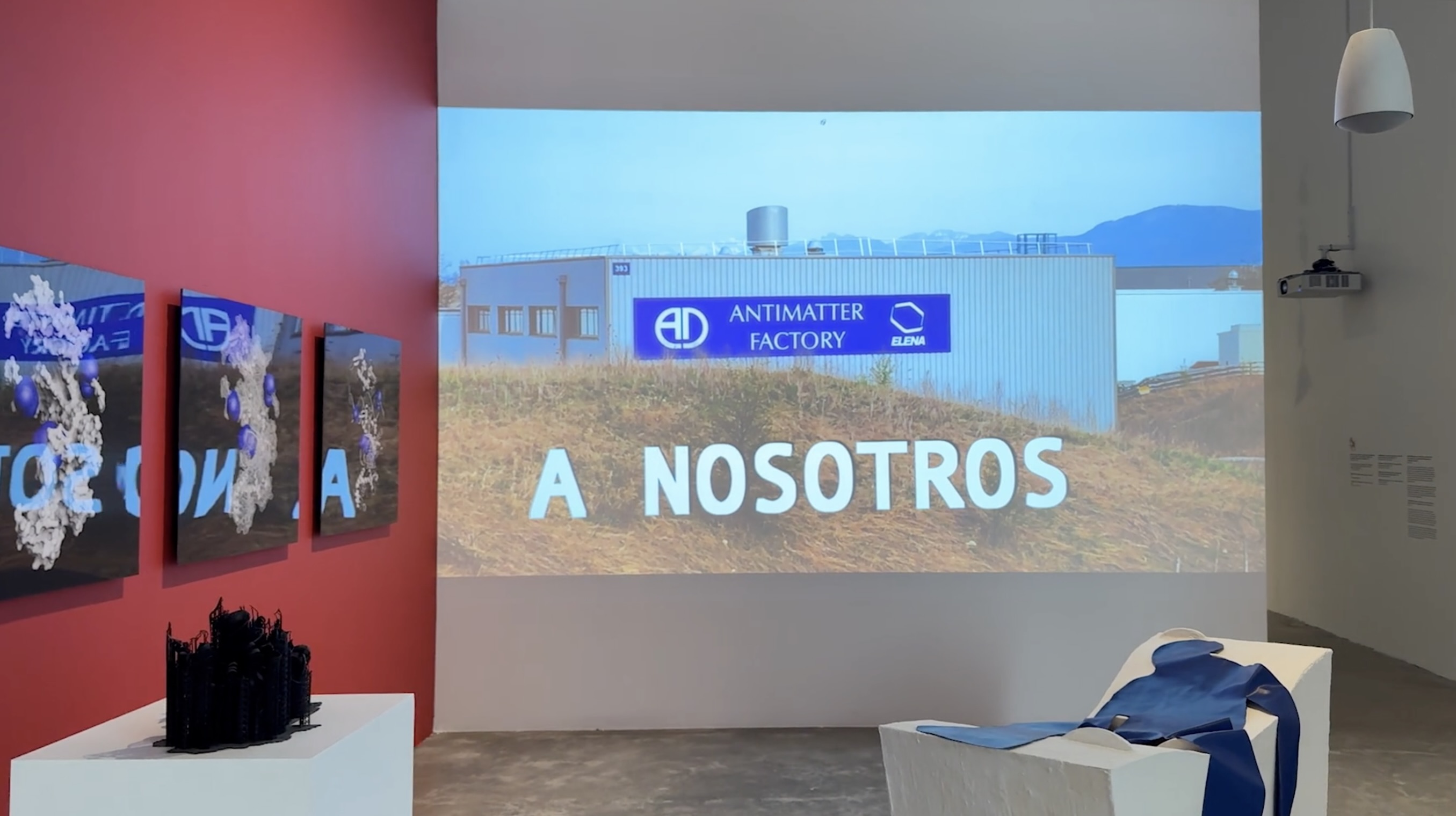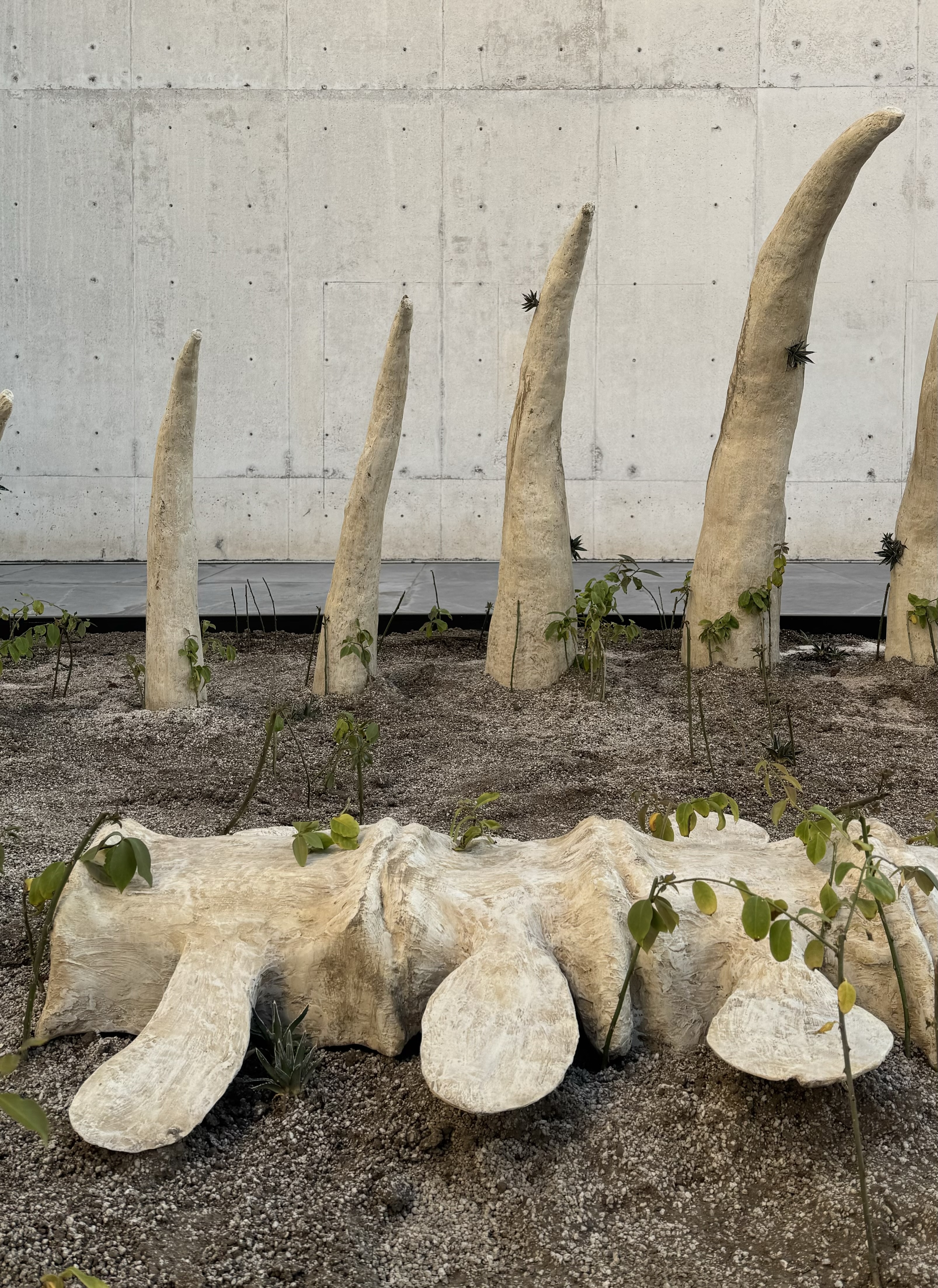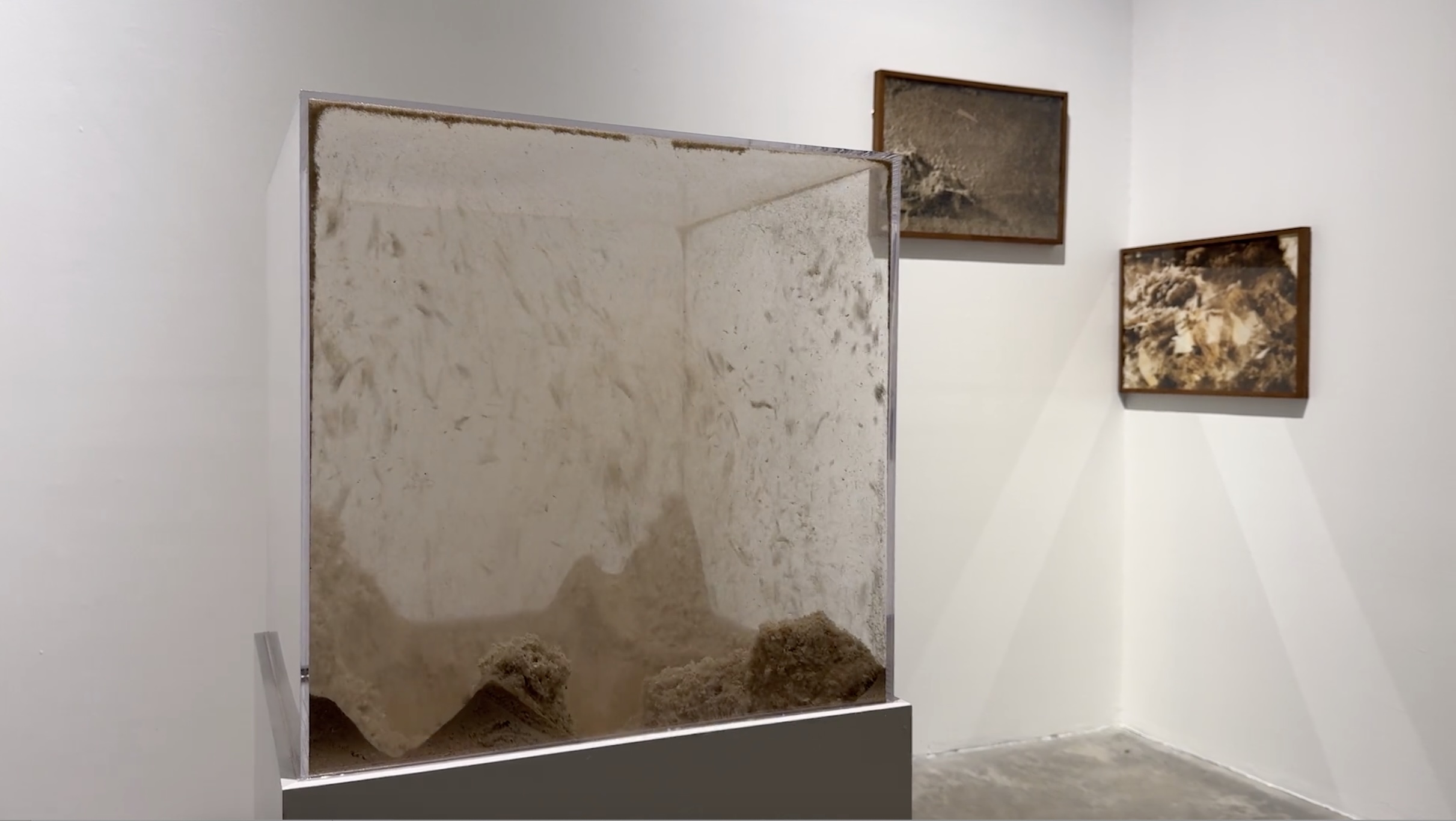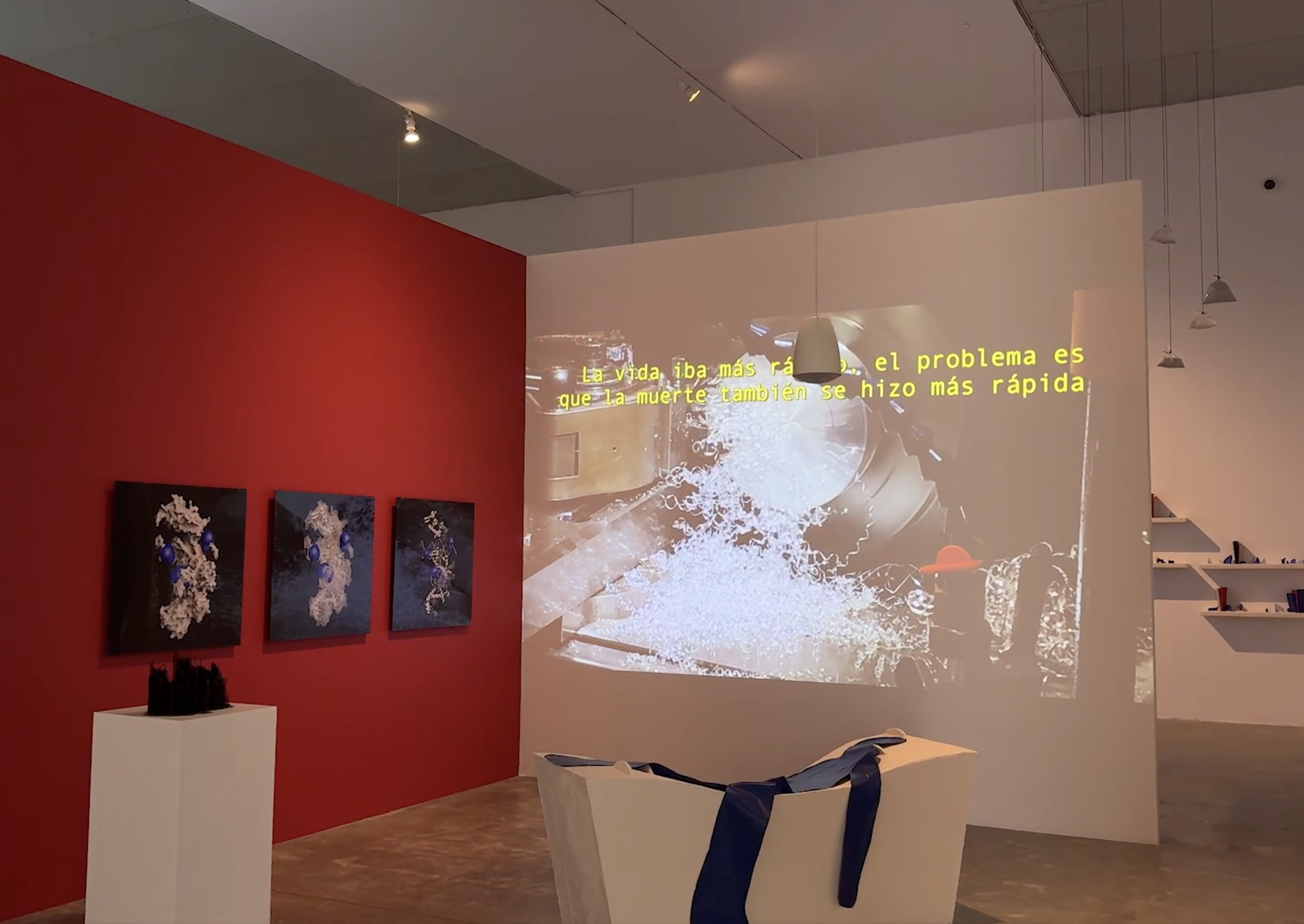
Review
Thirst for Radical Imagination: Julieta Aranda at the MUAC
by Sandra Sánchez
Reading time
7 min
Death is a gift of brutal tenderness toward the life that continues.
—Julieta Aranda
Prelude
Philip K. Dick—science fiction writer and, in my view, practitioner of hyperstition¹—wrote a character² who could erase what he didn’t desire through imagination. The others had to convince him to erase himself. How do we convince Donald Trump and Benjamin Netanyahu to erase themselves? Perhaps we can speculate a bit further: how can we manufacture the self-destruct button for fascism?
A Thought:
Human bodies are necessary, even for science fiction, to test space.
Even the invisible needs a physical structure.³
Is thought visible or invisible? Is sound a mode of thought? Can we think without audiovisual experience and production?
Thinking with images, thinking with sounds, thinking with affects and percepts. Concepts that, in their abstraction, maintain a connection to life and its problems, making sense for the communities that use them—just as choreographer and philosopher Marie Bardet would say.
"Absolutely materialist abstractions.⁴"

Clear Coordinates for Our Confusion
Coordenadas claras para nuestra confusión is the title of Julieta Aranda’s solo exhibition (Aranda is also co-editor of e-flux) at the Museo Universitario de Arte Contemporáneo (MUAC). Curated by Alejandra Labastida, the exhibition proposes time as the thread guiding the interpretation of the work. Linear time—hierarchical time—is the enemy confronted here, with emphasis on the idea that each materiality produces its own temporality. “Time is the fermentation of matter,” says the collective Manifestos for a Biodegradable Art.
Thus, the exercise of temporal rupture is played out in terms of radical imagination, but always with a correlation to the scales of the living—the biological, chemical, and physical components, their genealogies, and possibilities. In other words, the radicality of the imaginative exercises in each piece lies in abandoning the seduction of abstraction and the artist’s individual figurations, opening that personal position to the interactions between different forms of matter.
The works focus on both the speculative possibilities of other times and the vibrant matter we co-inhabit—and of which we are a part. Special attention is given to the geopolitics of matter and its technical unfoldings: from modes of subjectivation that dismantle the self to embrace sympoiesis⁵, to machines like microscopes, cameras, and other devices that at times act as prosthetics—not of a body, but of interactions between bodies—that dismantle and assemble our visualities, vital practices, and, of course, collective imagination. A kind of delirium we can tap into, not to provoke an individual psychotic break, but to stop believing that capitalism is infinite, that there are no ways out. In fact, the escape is already underway.
![Another End of the World Is Possible [Otro fin del mundo es posible], 2022. Detail from the publication “Julieta Aranda. Coordenadas claras para nuestra confusión, MUAC/UNAM, 2024”.](https://firebasestorage.googleapis.com/v0/b/prod-ondamx-art.appspot.com/o/media%2F1737725644128-7.jpg?alt=media&token=dc76a919-38df-4b9d-872e-e3d02185d7cf)
In Another End of the World Is Possible (2022), a series of seven photographic prints, Aranda responds to her son during the pandemic about death. Using her child’s food scraps, she creates photomicrographs to explain that when we die, we transition from a “small world” to a “big world.” “When we die, we become life again. [...] Death is a gift of brutal tenderness toward the life that continues,⁶” the artist explains. In this piece, scales shift—not only visually, where life and death are represented as a honeycomb with voids, interactions, and flows—but also subjectively, as one’s death inescapably involves other ecologies. The end is not a totality but part of the kinetics of different strata.
In this same vein, I’d like to highlight A Machine for Perpetual Possibility (2008), in which Aranda presents an acrylic box with a programmed air compressor circulating pulverized science fiction books. These texts share a commonality: they are set in futures that never materialized, like 2001: A Space Odyssey and Blade Runner (Do Androids Dream of Electric Sheep?)

![A Machine for Perpetual Possibility [Una máquina para la posibilidad perpetua], 2008. Detail from the publication “Julieta Aranda. Coordenadas claras para nuestra confusión, MUAC/UNAM, 2024.”](https://firebasestorage.googleapis.com/v0/b/prod-ondamx-art.appspot.com/o/media%2F1737725593285-4.jpg?alt=media&token=7aa59be6-ea93-4a6e-9c74-0c31c124c7c9)
The power of imagination doesn’t lie in its realization or its truth or falsehood⁷, but in having parameters that awaken us from the capitalist nightmare where the body is conjured as part of a fascist aesthetic-ethical regime (the logic of whiteness.) Imaginations that help us abandon the thought that some people are inherently better than others, where exploitation is normalized, and violence is justified for the accumulation of economic capital, which in turn sustains systems of injustice and violence. These pulverized science fiction books imagined futures that didn’t quite come to pass, but they offer tools for improvisation, providing options at hand, in mind and body, to react to norms imposed by power, to disrupt devices that equate the visible with the sayable. They foster a glitch, a detour, a transmutation in the system, whether that system is the body and its connections or the world and its cruelties.
Stealing One’s Own Corpse (An Alternative Set of Footholds for an Ascent into the Dark)
The video installation consists of four parts: four adjoining rooms, each with two walls. Seen from above, it forms a square divided into four sections. Each explores different ways of confronting the violence of the present, the construction of time, the idea of the end, and extinction, analyzing everything from climate change to technological change, as well as the powers that manage them.

An in-depth analysis of each part could form an essay in itself. What I’d like to highlight is how the artist uses audiovisual language to think, to offer ideas linked to theory-fiction, using sounds and images at different scales that not only record reality but also invent it and embed it in our bodies.
Antecedents such as Chris Marker, Harun Farocki, and Agnès Varda resonate in the production of these videos, along with the way we consume information on social networks. How can we generate collective thought about the collective? Aranda makes it clear that while books remain an important reference for this activity, contemporary modes of circulation and perception make it possible for thought to exist not only in written text but also in sound and visual montage. A production that is not written in the first person but articulated as a co-production that includes other agents like audio and image programs, different archives, chance, improvisation, and play.
![Stealing One’s Own Corpse (An Alternative Set of Footholds for An Ascent into the Dark) Part 3-Politics without Oxygen [Rescatando mi propio cadáver (Un conjunto alterno de peldaños de apoyo para un ascenso a la oscuridad) Parte 3-Política sin oxígeno], 2020. Still from the publication “Julieta Aranda. Coordenadas claras para nuestra confusión, MUAC/UNAM, 2024.”](https://firebasestorage.googleapis.com/v0/b/prod-ondamx-art.appspot.com/o/media%2F1737725671001-6.jpg?alt=media&token=3feb362f-04aa-42d0-b279-0cd939ce3e2c)
![Stealing One’s Own Corpse (An Alternative Set of Footholds for An Ascent into the Dark) Part 4- (Look for Patterns, and You Will Find Them), [Rescatando mi propio cadáver (Un conjunto alterno de peldaños de apoyo para un ascenso a la oscuridad) Parte 4-(Busca los patrones y los encontrarás], 2024. Still from the publication “Julieta Aranda. Coordenadas claras para nuestra confusión, MUAC/UNAM, 2024.”](https://firebasestorage.googleapis.com/v0/b/prod-ondamx-art.appspot.com/o/media%2F1737726388466-8.jpg?alt=media&token=7884b285-1a70-4d50-93b8-25a2279f36d0)
Perhaps radical imagination includes not only abandoning the solitary author as the first-person producer but embracing assemblage as a technology of the commons: not just textual citations, but also visual and sonic ones. Stimulations made not only in the first person but as a production of productions, on various scales. Burrows, not straight lines.
Clear Coordinates for Our Confusion can be visited until May 11, 2025, in rooms 7 and 8 at MUAC.
Translated to English by Luis Sokol
[1]Mark Fisher defines hyperstition, a concept he coined with the CCRU and Nick Land, as "the (techno)experimental science (with all the ambivalent characteristics of the unforeseen) of self-fulfilling prophecies, of fiction that becomes real." In Mark Fisher. Constructos flatline. Materialismo gótico y teoría-ficción cibernética. Caja Negra, Buenos Aires, 2022.
[2] Philip K. Dick. Eye in the sky. Thanks to Eric Valencia for this story.
[3] Heard in Stealing One’s Own Corpse (An Alternative Set of Footholds for an Ascent into the Dark) by Julieta Aranda
[4] Ibid, Mark Fisher.
[5] Donna Haraway, Seguir con el problema. Generar parentesco en el Chthulceno. Consonni, Bilbao, 2019. When thinking about kinship, Haraway considers the shift from autopoietic systems (which create themselves) to sympoietic ones, "always associated, without starting units." M. Beth Dempster uses the term sympoietic to define "collectively produced systems that have no self-defined spatial or temporal boundaries. Information and control are distributed among the components. The systems are evolutionary and have the potential for surprising changes."
[6] Julieta Aranda. Virtual tour, in https://muac.unam.mx/exposicion/julieta-aranda, consulted on January 20th, 2024.
[7] See Gilles Deleuze. Cine III. Verdad y tiempo, potencias de lo falso. Cactus, Buenos Aires, 2018.
Published on January 24 2025